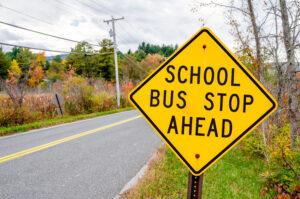The ongoing impacts of school bus driver shortages

The 2021–2022 school year was supposed to be the year when things went “back to normal.” As schools reopened in the fall, parents, teachers, and students alike were eager to regain a sense of normalcy by returning to a regular, in-person school schedule. But complications related to the ever-evolving COVID-19 pandemic — including new variants and a continuing nationwide school bus driver shortage — soon made it clear that things were anything but back on track.
Having too few school bus drivers is not a new
issue for school districts, but it is a problem that has soared to new heights since the onset of the pandemic. Rather than take on additional pandemic-related risks and responsibilities, thousands of school bus drivers across the country have opted to resign, retire early, or switch to different types of driving jobs that offer higher pay, a better schedule and more robust benefits.
As we ease our way into a new year, the impacts of school bus driver shortages are still being felt far and wide by students, parents and school administrators and staff. The real-life stories unfolding across the country about delayed buses, revised school schedules, the reinstatement of remote and hybrid learning, and school closures seem to be never-ending — and are, unfortunately, nothing new. And the Omicron variant is adding a new wrinkle to an already burgeoning problem.
In Honolulu, Hawaii, the Department of Education suspended two dozen school bus routes statewide, leaving many families to fend for themselves — and numerous students stuck at home with no way to get to school.
Escambia County School District in Florida hired 20 new bus drivers this school year but is still short 50 drivers. As a result, the district has been forced to stagger school schedules, which can be an effective strategy — as long as no drivers are out sick. With the Omicron variant wreaking havoc, however, staffing shortages due to illness have been unavoidable.
Having run out of options, schools in southwestern Michigan and Indiana have reluctantly reverted to remote learning. “We do not feel that we (can) combine routes any further, extend driving hours or route length, and provide the high level of safety our district and community has come to expect,” said Edwardsburg Schools Superintendent James Knoll.
In Ossining, New York, parents are being encouraged to drive their children to school due to a transportation staffing shortage that is forcing the district to alternate class schedules and delay bus routes.

Federal and state government agencies — along with school districts across the country — are trying many different things to alleviate the bus driver shortage, including offering higher wages and hiring incentives, improving benefit packages, changing policies, and waiving or eliminating certain commercial driver’s license (CDL) requirements to make it easier and faster to onboard new drivers. Other, more unusual approaches have also been attempted.
In Massachusetts, National Guard troops were brought in to drive buses in order to make sure kids got to school. Montgomery County Public Schools in Maryland recently made a similar request to address significant bus driver staffing shortages that have resulted in 40 to 80 school bus routes beingcanceled.
In Springfield, Missouri, the Republic School District superintendent and other school administration officials are taking a different tact: They are working on getting their CDLs themselves so they can climb behind the wheel and help get students to and from school and other activities.
In North Carolina, the Department of Motor Vehicles has launched virtual driver’s certification training classes to make them accessible to more potential school bus drivers.
In recognition of the ongoing nature of the school bus driver shortage, Clark County School District in Las Vegas is taking proactive measures by adjusting school schedules for the upcoming 2022–2023 school year.

The various solutions being tried and tested by school districts and government agencies can be effective to some extent, but many of them offer only short-term, temporary relief. A lot of them are not sustainable. And the issues that created the problem remain.
There is no easy answer to school bus driver shortages. But the detrimental impact on children, families and schools nationwide means that political and educational leaders need to be open to new ideas — and ready to adopt creative, innovative solutions.
Case in point: Last year, Arizona created the Transportation Modernization Fund — a competitive grant program administered by A for Arizona aimed at enabling the development of innovative transportation solutions by schools, school districts, nonprofits, cities and other organizations. HopSkipDrive is proud to be partnering with Tolleson Union High School District — which won a $2M A for Arizona grant — to help the district achieve its school transportation and accessibility goals.

The A for Arizona grants are but one small step in the right direction towards the urgently necessary revitalization of the student transportation industry. According to a recent article by the Thomas B. Fordham Institute, a nonprofit education policy think-tank: “Policymakers are going to need to adopt a ‘flood the zone’ approach to student transport. Needs vary wildly by community, and no one-size-fits-all solution will be sweeping in to save the day. A pluralistic system of K–12 education requires a multi-modal system of student transport.”
As an innovative youth transportation solution, HopSkipDrive already partners with more than 300 school districts across the country. Utilizing data science and operational expertise, our RideIQ technology dynamically identifies the best rider and route combinations to minimize costs and maximize utilization. This approach allows districts to reserve school bus drivers for their busiest routes while still offering transportation to students through HopSkipDrive rides.
As the transportation needs of school districts continue to increase and evolve, we will continue to explore new ways to streamline transportation workflows and deepen the optimization features that help districts by augmenting existing resources.


